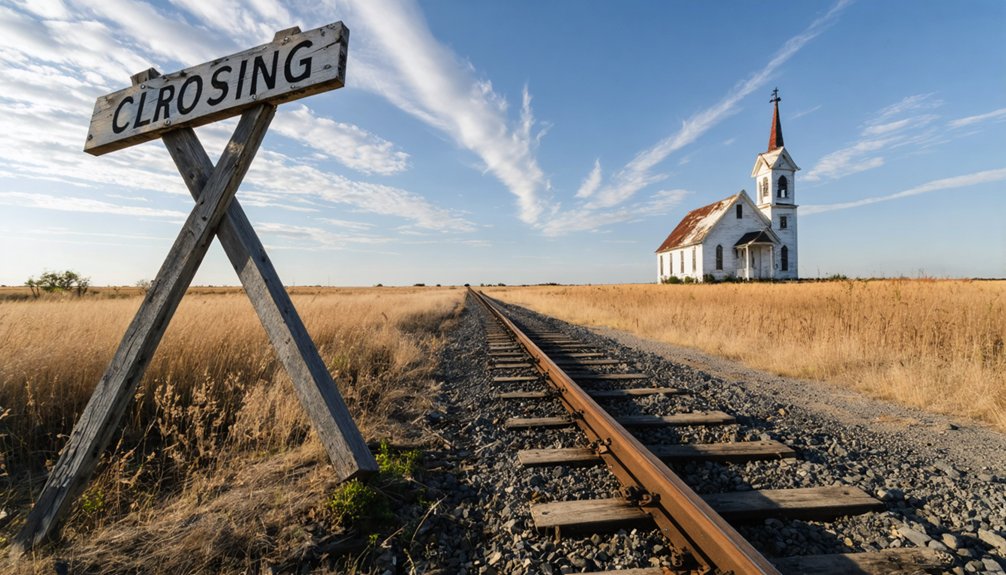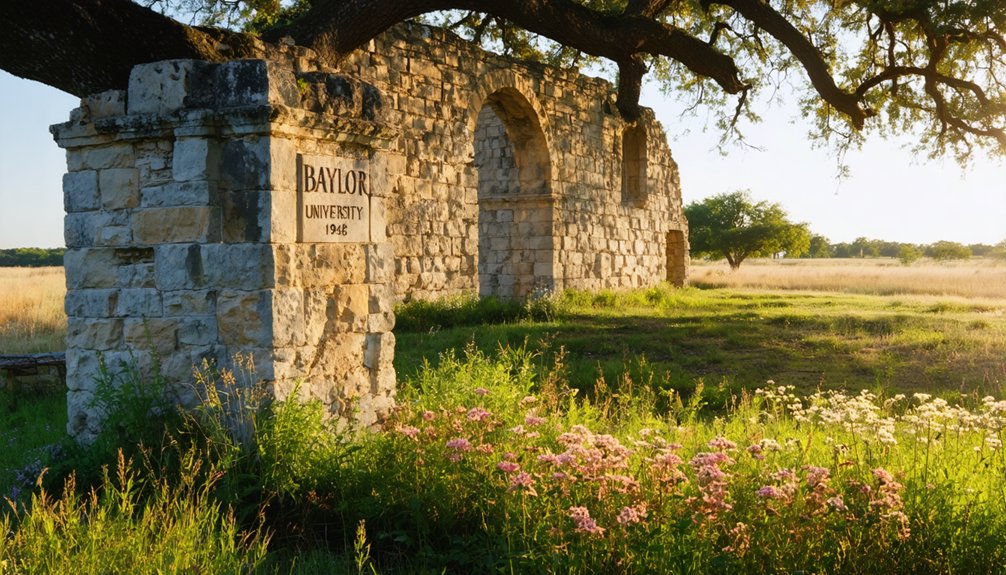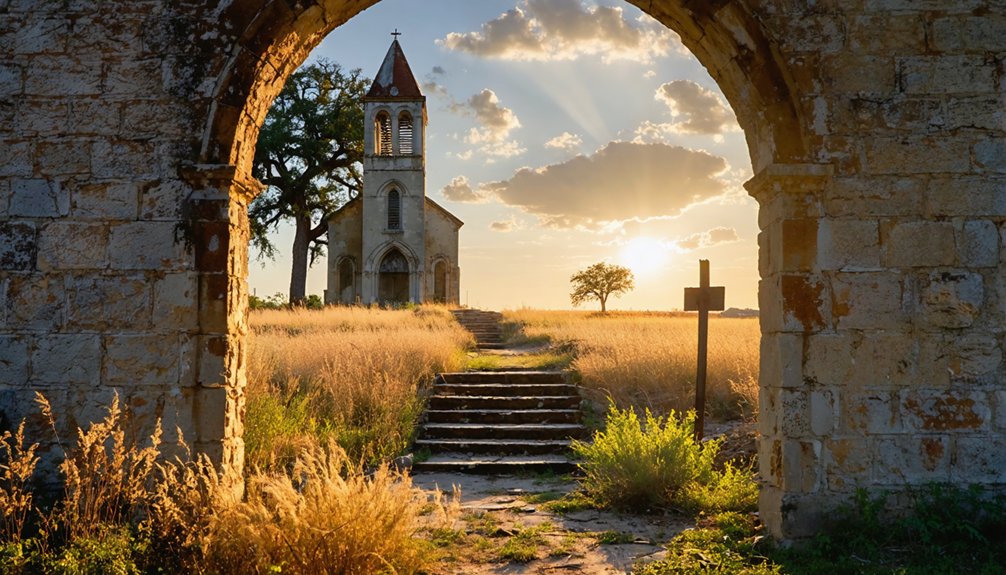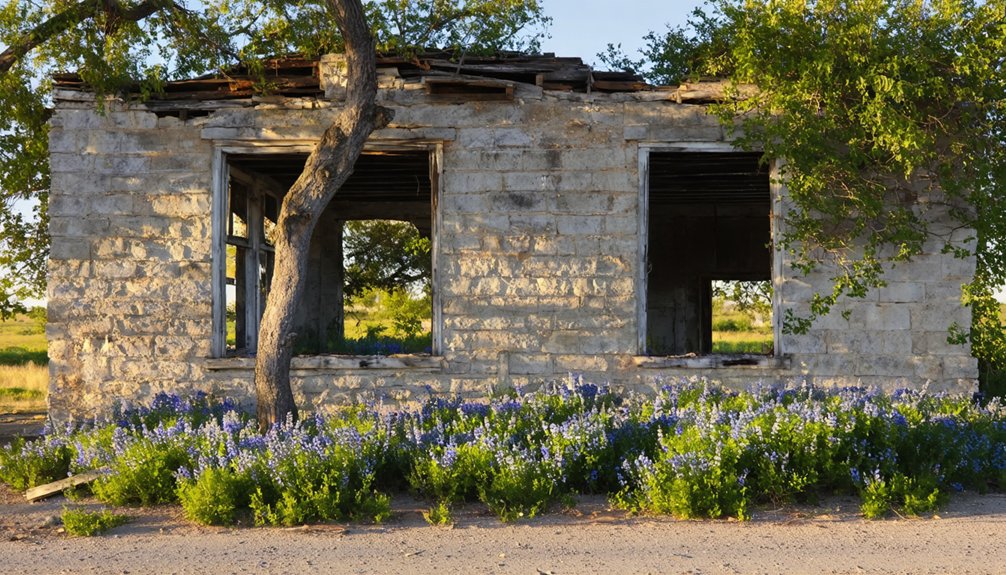You’ll find Independence, Texas tucked away in Washington County, where it once thrived as one of the Republic’s wealthiest communities and home to Baylor University. The town’s fateful decision to reject the Santa Fe Railroad in the 1880s, coupled with devastating natural disasters, transformed this educational hub into one of Texas’s most evocative ghost towns. Today, you can explore the ruins of original campus buildings, pioneer cemeteries, and Sam Houston’s former residence – each stone telling tales of frontier ambition and missed opportunities.
Key Takeaways
- Once a thriving educational center and home to Baylor University, Independence declined after rejecting the Santa Fe Railroad in the 1880s.
- Natural disasters, including an 1873 fire, 1882 tornado, and 1900 hurricane, severely damaged the town’s infrastructure and population.
- The departure of Baylor University and Baylor Female College by 1885 marked a turning point in Independence’s transformation into a ghost town.
- Historic ruins, preserved buildings, and pioneer cemeteries now attract tourists interested in early Texas history and ghost town exploration.
- The town’s original 78-acre layout, with its distinctive y-shaped blocks and central square, remains visible in the ghost town today.
The Birth of a Frontier Town
On December 2, 1835, as the Texas frontier was rapidly expanding, four ambitious land speculators – J. G. W. Pierson, Robert Stevenson, Colbert Baker, and Amasa F. Burchard – established what would become one of early Texas’s most prominent settlements.
They laid out Independence on 78 strategically chosen acres within Austin’s colony, designing a precise grid of 60 blocks around a central town square.
The town’s distinctive layout featured y-shaped blocks forming the main square, creating an organized foundation for future development.
You’ll find Independence’s founding perfectly timed with the spirit of frontier expansion and land speculation during the Republic of Texas era.
The speculators picked this Washington County location for its promising agricultural possibilities and strategic position along developing trade routes.
Their vision for the settlement reflected the optimism of Texas’s early pioneers, who saw unlimited potential in the vast frontier landscape.
The same year of the town’s founding, Frances Trask opened a boarding school for girls, marking the beginning of Independence’s role as an educational center.
Educational Hub of Early Texas
Independence’s educational legacy begins with one of Texas’ earliest universities, when the Union Baptist Association secured a charter in 1845 to establish what would become Baylor University.
You’ll find that Independence won the bid to host this pioneering institution precisely because it was Texas’ wealthiest community at the time.
The town’s selection as an educational center aligned with Mirabeau B. Lamar’s vision of public education and his famous motto celebrating “the cultivated mind” as democracy’s guardian. The educational progress under Lamar’s administration earned him recognition as the Father of Education in Texas. Despite the ambitious plans for education, the institution relied heavily on private initiatives as state funding remained insufficient throughout this period.
Early Baylor’s Pioneering Years
When Baptist leaders established Baylor University in Independence during 1845, they laid the foundation for what would become Texas’s pioneering center of higher education.
Baylor founders Tryon, Baylor, and Huckins faced early challenges as they transformed their vision into reality, securing $5,000 from Sam Houston as their first major donation.
You’ll find that the university’s humble beginnings in 1846 included just 24 students studying in a borrowed building on Academy Hill.
Under President Henry Lee Graves’ leadership, the institution quickly expanded to include collegiate studies and law lectures. The school saw its first graduate in 1854, marking a historic milestone for higher education in Texas.
The separation of male and female departments in 1851 marked a significant evolution, with men relocating to Windmill Hill while women remained at the original campus.
This innovative structure became a model for education in the young Republic of Texas.
The university would eventually relocate to its current 1,000-acre campus in Waco, Texas, where it continues to thrive as a major Baptist institution.
Local Schools Shape Texas
While Baylor University anchored Independence’s reputation for higher education, the town’s broader educational landscape took root much earlier.
You’ll find that private schooling began here in 1835, well before public education took hold.
The community’s commitment to learning gained momentum when the Republic of Texas, under Mirabeau B. Lamar’s leadership, established essential education funding through land grants. Each county received 18,000 acres to support local schools.
This educational evolution continued with the establishment of tax-supported public schools in the 1870s.
Sam Houston’s Connection
In Independence, you’ll discover Sam Houston’s deep family connections through his historic estate, where he lived with his wife Margaret Lea Houston and their eight children.
You can still see remnants of their homestead, which served as both a family residence and a hub for Houston’s political activities during the Republic of Texas era. After his successful military leadership in the Battle of San Jacinto, Houston continued to shape Texas’s destiny from this very location.
The property’s original location near Baylor University’s first campus reflects Houston’s strategic choice to maintain close ties with Texas’s emerging educational and political center. His unwavering loyalty to the Union during the Civil War era made his time in Independence particularly challenging.
Houston’s Family Life Here
Sam Houston’s connection to Independence, Texas ran far deeper than mere residency, as the settlement served as a pivotal hub for his family life during the Republic of Texas period.
You’ll find that the family dynamics here intertwined closely with Houston’s political influence, as his third wife Margaret Lea helped maintain their household while he navigated his demanding public career.
The town’s social fabric supported the Houston family through various changes, especially as Sam balanced raising his children with his duties as a Texas leader.
When he married Margaret in 1840, she became instrumental in managing their home life and supporting his political endeavors.
Their time in Independence reflected the resilience of early Texas frontier families, with Margaret overseeing daily life during Sam’s frequent absences for campaigns and public service.
Historic Home and Estate
The historic Woodland House stands as a tribute to Houston’s prosperous period during his U.S. Senate years.
You’ll find this impressive two-story Greek Revival home, built in 1847, featuring squared log construction and hand-hewn whitewashed boards that perfectly blend Southern style with frontier practicality.
The Woodland architecture included a detached kitchen and law office, both constructed with unfinished logs.
After Houston’s death in 1863, Margaret relocated to what’s now known as the Root House, a Greek Revival structure where she lived until 1867.
Both properties secured their place in the Houston legacy through historical markers and preservation efforts.
You can still visit these landmarks along Farm to Market Road 390, where they stand as evidence of Sam Houston’s significant role in Texas history.
Rise to Economic Prominence
Founded in the 1820s as Coles Settlement, Independence rapidly emerged as one of Texas’ wealthiest communities through its thriving cotton economy and educational prominence.
You’ll find the town’s cotton prosperity created a self-sustaining agricultural foundation that attracted farmers, merchants, and educated citizens alike.
The town’s meteoric rise showcased:
- Bustling cotton gins and mills that processed the region’s abundant harvests
- General stores and trading posts serving a growing population of wealthy plantation owners
- Educational prestige with Baylor University’s establishment in 1845
- The notable presence of Sam Houston, whose residence added political significance
This economic significance transformed Independence into a cultural and commercial hub, where cotton trade and academic pursuits created unprecedented wealth in Washington County’s fertile landscape.
Transportation Decisions That Changed Everything

Making what would prove to be a fateful decision, Independence’s leaders rejected the Santa Fe Railroad’s request for right-of-way access through their prosperous town in the late 19th century.
Independence’s historic blunder in denying railroad access sealed its fate, transforming a thriving town into a cautionary tale of missed opportunity.
You’ll find this choice created devastating transportation impacts that rippled through generations, leading to economic isolation that forever altered the town’s destiny.
The consequences were swift and severe. While neighboring towns like Brenham flourished with new rail connections, Independence struggled with inadequate roads and declining stagecoach service.
By 1885, you’d witness Baylor University and Baylor Female College relocate to Waco and Belton respectively, unable to thrive without reliable transportation.
The town’s commercial importance drained away as trade routes shifted to rail-connected communities, and even modern highway developments bypassed the once-influential settlement.
Natural Disasters and Setbacks
While Independence’s leaders grappled with their fateful railroad decision, nature dealt the town a series of devastating blows that accelerated its decline. The natural disaster impacts came in relentless waves that crippled the town’s resilience:
- An 1873 fire ravaged key infrastructure and weakened the local economy.
- A powerful tornado in 1882 destroyed homes and businesses.
- The devastating hurricane of 1900 decimated what remained.
- Severe flooding and storms continued to plague recovery efforts.
You’ll find these disasters struck at Independence’s very foundation, destroying cotton plantations and driving away residents.
Without railroad access to aid recovery, each catastrophe pushed the town closer to abandonment. The economic decline proved insurmountable as businesses relocated, Baylor University departed, and families sought opportunities in more accessible communities.
The Baylor University Legacy

Baylor University’s origins in Independence represent a pivotal chapter in Texas educational history. You’ll find the university’s early roots deeply intertwined with Texas heroes like Sam Houston, who donated $5,000 and later received baptism from President Rufus Burleson.
Baylor’s challenges in Independence shaped its future trajectory. The institution split into male and female departments across Independence Creek, nicknamed “The River Jordan.”
Despite reaching peak enrollment of nearly 500 students in 1861, post-Civil War struggles and regional economic decline forced difficult decisions. Historical leadership, including founders Robert E.B. Baylor and first president Henry Lee Graves, established strong academic foundations.
Ghost Town Tourism Today
After Baylor University’s departure, Independence transformed into one of Texas’s most evocative ghost towns.
Today, you’ll find this historic site draws history enthusiasts rather than mass tourists, with tourism trends favoring authentic experiences over commercial attractions.
As you explore Independence’s quiet streets, you’ll encounter:
- 19th-century ruins and preserved buildings that tell stories of Texas pioneer life
- Walking tours highlighting Baylor’s original campus grounds and pioneer cemeteries
- Museums and historical markers that document the town’s significant role in early Texas
- Special events and commemorations that bring the ghost town briefly back to life
While accessibility remains limited to rural roads, Independence’s authentic charm and historical significance continue to captivate visitors seeking genuine connections to Texas’s pioneering spirit.
Preserving Texas History

Throughout Texas, a dedicated network of historical commissions and grassroots organizations works tirelessly to preserve the state’s rich heritage.
You’ll find over 200 county historical commissions actively safeguarding historic markers, sites, and cultural assets under the guidance of the Texas Historical Commission.
Local preservation strategies rely heavily on community engagement, with volunteer boards managing everything from cemetery maintenance to museum operations.
You’ll see this grassroots approach in action through groups like the one formed in Helena back in 1962.
These dedicated caretakers collect historical photographs, oral histories, and artifacts while maintaining physical structures.
They’re also developing interpretive materials to share their town’s story with visitors.
Through their efforts, you’re able to experience authentic pieces of Texas history, preserved for future generations to explore and understand.
Frequently Asked Questions
What Happened to the Original Buildings of Baylor University in Independence?
Like scattered puzzle pieces of history, you’ll find most of Baylor University’s original Independence buildings were destroyed by fire, though you can still see preserved ruins and columns at today’s historical preservation site.
Are There Any Descendants of Original Independence Settlers Still Living There?
You’ll find very few, if any, direct descendants still living in Independence today. While family histories and descendant connections remain through local cemeteries and historical sites, most families relocated when the town declined.
What Was the Average Land Value During Independence’s Wealthiest Period?
You’d find land valuation during Independence’s peak economic prosperity varied from $5-20 per acre, with prime lots near Baylor University commanding top dollar during the 1850s-1870s boom period.
Did Independence Have Any Significant Role During the Civil War?
While Independence wasn’t a major battleground, you’ll find it served as a Confederate supply point and contributed men to Texas regiments. It’s notable for supporting the South’s war effort through resources and manpower.
How Many Original Structures From the 1830S-1850S Still Remain Standing Today?
Standing proud in historical preservation, you’ll find four architecturally significant structures: the Blanton Block, Robertson House, Adobe House, and Sam Houston’s residence – all evidence of Independence’s 1830s-1850s heritage.
References
- http://texappealmag.com/texas-ghost-towns-explore-haunting-remnants-of-forgotten-cities/
- https://www.amysatticss.com/ghost-towns/
- https://visitbrenhamtexas.com/things/tours-activities/washington-county-soundwalk-experience/independence/
- https://www.youtube.com/watch?v=6ov4fGRK9JI
- https://www.tshaonline.org/handbook/entries/independence-tx-washington-county
- https://www.texasescapes.com/TOWNS/Independence/IndependenceTexas.htm
- https://en.wikipedia.org/wiki/Independence
- https://visitbrenhamtexas.com/beyond-brenham/independence/
- https://www.southernthing.com/ruins-in-texas-2640914879.html
- https://www.ghosttowns.com/states/tx/independence.html



